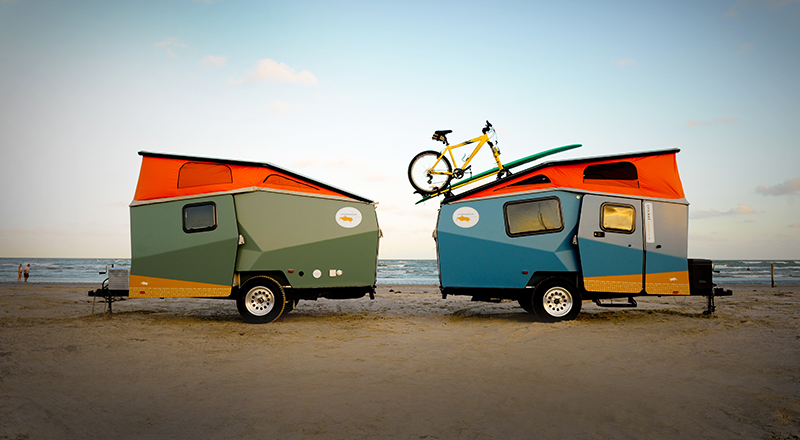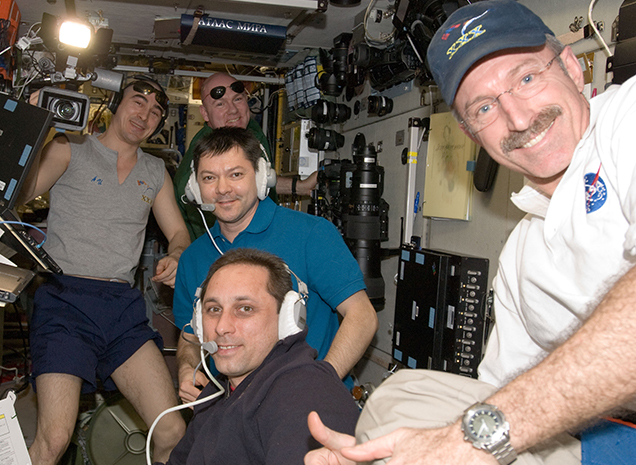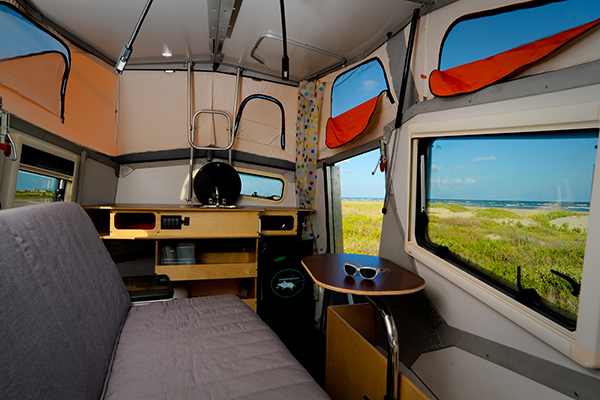
Space-Inspired Trailers Encourage Exploration on Earth
NASA Technology
An inch can make a world of difference. Which is why Garrett Finney moved the office coffeemaker into the full-size, cardboard mockup of the new trailer he was designing. The need for caffeine—and the threat of hot coffee accidentally dumped on a coworker—provided motivation and means for assessing the feasibility of a confined living space.
“We all had to go inside and bump into each other and figure out when 20 inches is much different from 21 inches in terms of the size of a table or passage,” Finney says.
Finney has what he calls a “nonstandard expertise in people in small spaces.” He developed it while part of a NASA team designing living quarters for the International Space Station (ISS).
Though its crew of six—plus one Robonaut—has space larger than a five-bedroom house to live and work in, the ISS is also packed with electronics, life-support systems, racks of experiments, and more. Then consider that all of these components must be built to strict performance specifications for operation in a harsh space environment.
“It’s very difficult to write human beings into those performance specs,” says Finney.
Then add in further complications such as microgravity; long-duration stays far from family and friends; the lack of any nearby maintenance assistance; and crewmembers with diverse backgrounds, cultures, and concepts of personal space. Accommodating all of these considerations while offering the greatest possible ease and comfort for the crew becomes a significant challenge.
Technology Transfer
In order to help address the problems arising from long-term living in space, NASA’s Johnson Space Center established the Habitability Design Center. In 1999, Finney, an award-winning architect in New York City, joined the center to collaborate with engineers on the design of a Habitation Module, planned as the main living quarters for the ISS crew.
“My interest in going there intellectually was to be working on the first permanent settlement, or home, in space. There’s science fiction, and then there’s that exciting place where dreams become reality, and I thought of the space station as that,” Finney says.
Whereas everything on the ISS must in a technical sense be operable and repairable by any crewmember regardless of that person’s size or strength, Finney explains, “That has nothing to do with irritation and emotion and function over time and comfort.” Finney formed a connection between the astronauts and the engineers, applying his architectural expertise not with an eye toward aesthetics, but instead “trying to remove irritation from astronauts’ lives.” This included finding space-friendly solutions to considerations that would be minor to those not orbiting hundreds of miles above Earth—such as a place, Finney says, “to accommodate a laptop and a book and a picture of your family, and yet not have it be wrong if you didn’t have a family photo. I wanted to let the crew use the space as they wanted. Physically, but also culturally, demographically.”
While Finney contributed a number of innovative approaches to living in space, including a table that substituted toeholds for chairs, funding for the Habitation Module was ultimately cancelled. (The partially built structure was later appropriated as a testbed for ground-based life support research.) Finney’s NASA experience, however, would prove a significant influence on his vision for “a piece of equipment people just happen to live in,” a new means for exploring Earth informed by the exploration of space.
Combining his NASA expertise with his love of the outdoors, Finney turned to an industry where space is also at a premium: recreational vehicles. In 2009, he launched Cricket, based in Houston, and set about designing the first Cricket trailer. Beginning with the coffee-machine-equipped cardboard model—testing ideas in full-scale cardboard form was a holdover from Finney’s time at NASA—the company soon arrived at a highly versatile, user-friendly trailer that it believes can revolutionize the camping experience and how people interact with the natural environment.
Benefits
“The RV industry in general makes houses on wheels,” Finney says. “We think many people want to—and should—leave their house at home.”
The Cricket trailer hits a midway point between camping and living. Suitable for a full hookup campsite or going completely off-grid, the trailer can accommodate two adults and two children for sleeping and can be customized with a range of features including a shower, refrigerator, toilet, an array of storage options, and more. As in space where every surface—floor, walls, ceiling—can be functional, Finney designed the Cricket for maximum utility by virtually any user. The children’s berths, for example, are suspended from the ceiling and serve as storage when not in use.
Designing for the ISS, Finney explains, meant accommodating crewmembers of different nationalities, each with different ideas of what personal space means, how close people should be when talking, how one acts when in a bad mood. “For Cricket, the question was how to design a trailer whose space evolved from the inside out and be able to claim with a straight face that it is perfect for a 75-year-old and a 25-year-old, a fly fisherman and a duck hunter and a family camper—even though it’s the same trailer.”
In a NASA-like way, Finney says, the company devised a shorter performance specification for the trailer. It designed the trailer to be light enough (1,300–1,400 pounds) to be towed by a 4-cylinder car and crafted an aerodynamic shape that is easy to see around and fits into most garages. And as is required of ISS equipment, the Cricket’s components are readily accessible and fixable. In that sense, “It’s more like a mountain bike than a house on wheels,” Finney says.
The Cricket trailer has attracted significant coverage from media outlets such as Dwell magazine and the Travel Channel. Finney hopes Cricket will prove the ideal tool for helping people connect with the natural world and revitalize interest in and sustainable use of the Nation’s park system.
“To be better stewards of our national parks, we need to go see them and fall in love with them again. We need to be inspired to be light on the land and part of the big ecosystem instead of pretending the parks are just postcards for looking at.”
When he talks about the Cricket trailer’s design, Finney says, he’s actually talking about what he learned at NASA.
“I’m tremendously glad I went to work at NASA and got a whole new set of eyes, a way to view the world and all the systems that interact in it.”

The International Space Station and everything onboard is built to strict performance specifications. How to make such an environment as comfortable as possible for the diverse international crew—especially given the unique conditions of low Earth orbit—posed a significant challenge to NASA architects and engineers.

Informed by the “nonstandard expertise in people in small spaces” that founder Garrett Finney acquired at NASA, Cricket’s trailers are designed as the ideal tools for exploring and reconnecting with our home planet. The Cricket trailer, Finney says, is “part of what a 21st century campground should be, and how it can be educational and sustainable.”














